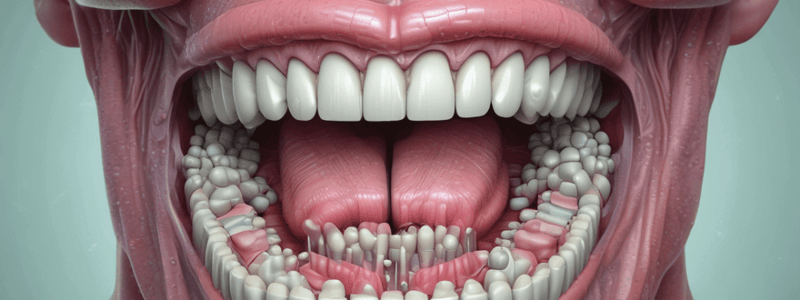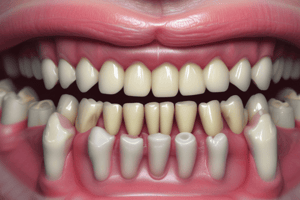Podcast
Questions and Answers
What is the final stage in maturation of epithelial cells?
What is the final stage in maturation of epithelial cells?
- Stratum cornium (correct)
- Stratum granulosum
- Stratum basal
- Stratum spinosum
What type of cells are shed from the epithelial layer, requiring constant turnover?
What type of cells are shed from the epithelial layer, requiring constant turnover?
- Non-keratinocytes
- Epithelial squames (correct)
- Keratinocytes
- Merkel's cells
What is the characteristic of keratinocytes in terms of their arrangement?
What is the characteristic of keratinocytes in terms of their arrangement?
- They are arranged in different layers (correct)
- They are arranged in scattered cells
- They are arranged in a single layer
- They are arranged in a random pattern
What is the function of keratinocytes during maturation?
What is the function of keratinocytes during maturation?
What is the characteristic of non-keratinocytes in terms of their staining?
What is the characteristic of non-keratinocytes in terms of their staining?
What is the characteristic of non-keratinocytes in terms of their arrangement?
What is the characteristic of non-keratinocytes in terms of their arrangement?
What is the characteristic of Langerhan's cells in terms of their shape?
What is the characteristic of Langerhan's cells in terms of their shape?
In which layers are Merkel's cells typically found?
In which layers are Merkel's cells typically found?
What is the primary function of the submucosa in the mouth?
What is the primary function of the submucosa in the mouth?
What is the layer of the lamina propria that comes into contact with the epithelium?
What is the layer of the lamina propria that comes into contact with the epithelium?
What is the reason for the avascular nature of the epithelium?
What is the reason for the avascular nature of the epithelium?
Where are the capillary loops found in the oral cavity?
Where are the capillary loops found in the oral cavity?
What is the purpose of the deep plexus of vessels in the submucosa?
What is the purpose of the deep plexus of vessels in the submucosa?
What is the composition of the submucosa?
What is the composition of the submucosa?
What is the function of the submucosa in regards to the minor salivary glands?
What is the function of the submucosa in regards to the minor salivary glands?
What occurs in areas of the mouth where the submucosa is absent or limited?
What occurs in areas of the mouth where the submucosa is absent or limited?
What is the origin of melanocytes?
What is the origin of melanocytes?
What is the function of melanocytes?
What is the function of melanocytes?
What is the composition of the lamina densa?
What is the composition of the lamina densa?
What is the location of the lamina lucida?
What is the location of the lamina lucida?
What is the function of melanophages?
What is the function of melanophages?
What is the characteristic of melanocytes in the epithelium?
What is the characteristic of melanocytes in the epithelium?
What is the role of connective tissue in the basement membrane?
What is the role of connective tissue in the basement membrane?
What is the name of the structure formed by the junction of epithelium, connective tissue, and basement membrane?
What is the name of the structure formed by the junction of epithelium, connective tissue, and basement membrane?
What type of papillae are found on the posterior third of the tongue?
What type of papillae are found on the posterior third of the tongue?
Which type of salivary gland is associated with the circumvallate papillae?
Which type of salivary gland is associated with the circumvallate papillae?
What type of mucosa is found on the floor of the mouth and the vestibular fornix?
What type of mucosa is found on the floor of the mouth and the vestibular fornix?
What is the function of the lingual tonsil?
What is the function of the lingual tonsil?
What type of epithelium is found on the ventral surface of the tongue?
What type of epithelium is found on the ventral surface of the tongue?
What is the characteristic of the epithelium at the mucogingival junction?
What is the characteristic of the epithelium at the mucogingival junction?
What is the characteristic of the connective tissue at the mucogingival junction?
What is the characteristic of the connective tissue at the mucogingival junction?
What is the characteristic of the submucosa at the vestibular fornix?
What is the characteristic of the submucosa at the vestibular fornix?
What is the characteristic of the epithelium on the firmly attached mucosa?
What is the characteristic of the epithelium on the firmly attached mucosa?
What is the function of the Weber salivary gland?
What is the function of the Weber salivary gland?
What is the primary function of the oral mucous membrane?
What is the primary function of the oral mucous membrane?
Which of the following is NOT a function of the oral mucosa?
Which of the following is NOT a function of the oral mucosa?
What is the purpose of papillae in the lamina propria?
What is the purpose of papillae in the lamina propria?
Which layer of the oral mucosa is responsible for producing saliva?
Which layer of the oral mucosa is responsible for producing saliva?
What is the function of the reticular layer in the lamina propria?
What is the function of the reticular layer in the lamina propria?
Which receptor is responsible for the gagging reflex?
Which receptor is responsible for the gagging reflex?
What is the term for the process by which animals regulate temperature through evaporation of water?
What is the term for the process by which animals regulate temperature through evaporation of water?
Which of the following is an example of a masticatory mucosa?
Which of the following is an example of a masticatory mucosa?
Flashcards are hidden until you start studying
Study Notes
Epithelium
- The final stage of maturation in keratinized epithelium is the cornified layer, where cells are termed epithelial squames that shed, necessitating constant turnover.
- Keratinized epithelium consists of stratum corneum, stratum granulosum, stratum spinosum, and stratum basal.
- Non-keratinized epithelium lacks a stratum corneum and stratum granulosum.
Keratinocytes
- Keratinocytes constitute the major part of epithelial cells and are arranged in different layers.
- During maturation, they either change to keratin or participate in keratin formation.
- Keratinocytes have the following characteristics: • Always present in sheets and attached to each other by one or more types of cellular junctions. • Cytoplasm is stained with H&E. • Cytoplasm contains tonofilaments.
Non-Keratinocytes
- Non-keratinocytes are present in both keratinized and non-keratinized epithelium and have the following characteristics: • Appear as clear cells by ordinary H&E stain and require special stains. • Present as scattered cells and not in sheets. • A clear halo around their nuclei. • Cytoplasm is free from tonofilaments. • No cellular junctions. • Do not play a role in synthesizing keratohyaline granules or keratin.
Non-Keratinocyte Types
- Pigment cells (melanocytes) have a small body with long, slender, and branched processes, and contain melanin.
- Langerhans cells have a similar shape, contain granules (Langerhans granules), and are located in the basal and parabasal layers.
- Merkel cells have no long processes, contain small membrane-bound granules, and are located in the basal and parabasal layers.
Junction of Epithelium and Connective Tissue
- Connective tissue, with its inductive properties, exerts control over the overlying epithelium.
- The basement membrane consists of three parts: lamina lucida, lamina densa, and lamina reticularis.
- Type IV collagen and laminin are major components of the lamina densa.
- The blood supply consists of a deep plexus of large vessels in the submucosa, which gives rise to a secondary plexus in the papillary layer of the lamina propria.
Lamina Propria
- The lamina propria consists of the papillary layer and reticular layer, below which is the submucosa.
- The lamina propria may be directly attached to the periosteum of alveolar bone or overlay the submucosa.
- Submucosa contains glands, blood vessels, nerves, and adipose tissue.
Submucosa
- Submucosa is formed of connective tissue, which determines whether the mucous membrane is loosely or firmly attached to the underlying structure.
- Submucosa serves primarily as an attachment for the lamina propria to the underlying bone or skeletal muscle.
- Submucosa is found in the cheeks, lips, and parts of the palate, and is a less dense component than the lamina propria.
Functions of Oral Mucosa
- The oral mucosa has the following functions: • Protection: protects deeper tissues and structures from mechanical, thermal, and chemical agents. • Sensation: senses temperature, touch, pain, taste, and other sensations. • Secretion: produces saliva. • Thermal regulation: regulates temperature through evaporation of water.
Histological Structure of Oral Mucosa
- The oral mucosa consists of two major components: oral epithelium and lamina propria.
- The lamina propria is divided into the papillary layer and reticular layer.
- In areas where mechanical adhesion between the epithelium and lamina propria is required, an increase in the number and length of papillae is seen (masticatory mucosa).
Studying That Suits You
Use AI to generate personalized quizzes and flashcards to suit your learning preferences.




